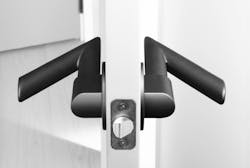Door handle and latch designs have been the same since 1878 (with the exception of the advent of the lever in the 1970s). A prototype called The World’s Best Door Handle brings a new shape and functionality to the opening. This is billed as the first manually operated mechanical door handle that does not require the user to grip and then twist something.
This patented product, in development by the company behind the RestroomUP LoK, also features three-dimensional status indicators on both sides of the door, ensuring maximum accessibility and communication clarity.
Jon Buss, Buss Innovations, notes that the lock is not yet in production. He is looking to partner with a North American manufacturer and bring it to market.
Latch
Buss explained that the latch and strike must work in cooperation to open traditional doors. Users need to manually turn the knob or press the lever, retracting the latch.
“What we've done is we've completely changed everything to make this door handle that we all know much, much more simple and much more accessible. There's no need to manually twist anything to manually get this latch out of the way, so it can go past the door strike. That's the key to this whole thing,” he said.
With this new type of lock, users don’t have to turn the knob or push down the lever to open the door, From the outside, the door can literally be pushed right open with an elbow, wrist, knee or foot. The door hardware is stationary, with no need to rotate. So there is nothing to move on this mechanical lock and no power is required to operate it.
The outside is non-locking. Most notable is that the door handle on the inside of the room is three tools in one:
- The object which one can connect with to move the door.
- The object that controls the internal deadbolt that locks the door.
- The object that shows, in three-dimensional space, the locked status of the door.
From the inside, users simply push down on the one movable piece – the inside door handle – to engage the lock, which includes a three-dimensional privacy indicator.
For persons with low vision, the indicator is tactile and three-dimensional. If opening and closing doors with the gripping hand is a problem or users’ hands are full, a simple push will open the door.
Pushing down the latch from the inside, one simple motion, activates the deadbolt and turns the indicator to “occupied.”
“In an open and close situation, but there's no moving parts on the handles at all during open and closed and locking, that's where most of the movement takes place.
With this guy deadbolting the latch in there, that's it. So it's much simpler. There's far fewer things to think about, far fewer things to do and again, hands-free if necessary,” Buss explained.
Door Prep
This is a retrofit product intended for residential and commercial applications, with a simple, straightforward installation. It fits doors with standard 1-3/4-inch or 2-3/4-inch backsets.
“The product is designed to fit the door industry standard door prep. Nothing special at all is needed -- no, after screws, no extra holes, nothing,” Buss said.
Changing the lock from passage to locking is done with one simple step, and an included tool enables emergency unlocking from the outside (in case a person inside is having an emergency.
Many indicator lock models contain dozens of parts, Buss noted, adding that his new product contains a total of eight parts. It's also been designed to be manufactured domestically. “As opposed to offshore, where there's a lot of very intricate small sheet metal forming, this has been designed for manufacture in North America.”
Because it's because it's sort of simplified and has fewer parts than the cylindrical locks, durability is increased. However, the Builders Hardware Manufacturers Association (BHMA) has not tested this product since it doesn’t quite fit their testing protocols, where, for example, the lever would need to be rotated half a million times. There’s nothing to turn on this lock.
“We actually did our own BHMA testing and you can see the results where we show our testing procedures and crank up to like half a million openings,” Buss said.
Manufacturing Outlook
Some big names in the industry are reviewing this product, with an eye towards a partnership, according to Buss.
“We need to find a partner because we're based in Canada and manufacturing costs are very high here as they are in the United States. Now that's probably going to change, but we have designed it so that a company that's already in the business that has existing sales channels and marketing distribution systems will do quite well with it. To get this to market, we need a company that has in-house capabilities of manufacturing and sales distribution channels. That's the key.”
The company did produce its original product, the hands-free Restroom UpLock, still in production and available, though the company is no longer promoting or advertising it, he said. It saw some success in the restaurant industry and in the post-Covid days as a hands-free lock.
“Our focus is on the new product and getting a partner to take over the restaurant lock so that we have a version specifically for commercial single-user restrooms and then we have the general product that will go residential and offices,” Buss noted.
For more information, visit www.restroomlock.com
